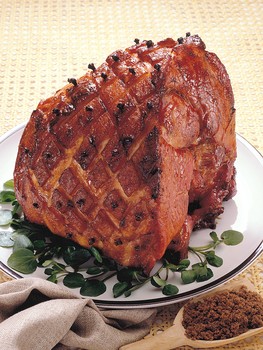How to Bake a Ham
Baked ham is one of America’s most beloved dinners. Holidays such as Christmas and Easter typically center around a juicy, delicious, baked ham with an assortment of trimmings. In keeping with its popularity, baked ham is not difficult to make. However, it does take a while to cook and, in some cases, it can take a long time to thaw if the ham you have selected was previously frozen. This delicious comfort food makes for great leftovers as well, assimilating easily into a variety of soups, sandwiches, and stews among other things. Ham bones also make a great flavoring agent for making soup.
When deciding on what type of ham to purchase, there are several things to consider. First, you should decide whether you want to buy a boneless ham, which some people feel is easier to serve because you don’t have to carve around the bone. Also, the weight of the ham is closer to the true weight of edible meat as there is no bone to offset the scale and only water loss during cooking will affect the cooked vs. pre-cooked weight.
Those who prefer the bone in (or “picnic” style ham) tend to feel that the flavor and texture of the meat is superior to the boneless variety. This is in part due to the higher fat content which is a flavor enhancer and also helps to keep the meat moist. After deciding whether to get a bone in or bone out ham, you need to choose between smoked, honey glazed or plain ham. Take into consideration the other components of the meal before making this decision. Would your side dishes be complimented by a smoky meat or a mildly sweet tasting meat? Some hams come spiral cut and some do not.
After making your ham selection, it is important to observe a few simple rules to avoid bacterial contamination in the form of food poisoning. Ham should always be refrigerated at a temperature of 40 degrees or less. Ham should also be used within a day or two of the sell by date found on the packaging it came in. If you cannot prepare it in this time frame, either discard it or freeze it. Ham should always be cooked to an internal temperature of 160 degrees Fahrenheit to make sure any harmful bacteria have been neutralized.
Baked Ham Recipe

How to Bake a Ham
- 1 frozen ham, uncooked
- Equal parts powdered mustard and brown sugar (optional)
Step 1
Remove the ham from the freezer and thaw it by immersing it in cold water for roughly 20 minutes per pound of ham. Make sure that the ham is sealed in a watertight wrapping to prevent it from coming into contact with the water. Furthermore, make sure you change the water every 30 minutes to guard against bacterial growth. Make sure that the ham is fully covered by the water.
Step 2
Pre-heat the oven to 325 degrees Fahrenheit and place the thawed ham in an aluminum foil lined roasting pan with the fatty side up. The fat will run down the ham as it melts. This will keep the meat moist and negate the need for basting. Leave the ham uncovered and do not add water to the basting pan as this is unnecessary.
Step 3
Allow 20-30 minutes per pound of uncooked ham. Once again, a meat thermometer is the best way to test if the ham is fully cooked. Halfway through baking the ham, flip it over so that the juices are distributed evenly. Try not to poke holes in the ham while it bakes because the juices will run out and dry out the ham. If you would like to add a spicy crust to your ham, mix equal parts of the dry mustard and brown sugar. Evenly and thoroughly cover the surface of the ham 30 minutes prior to taking it out of the oven.
Step 4
Once the ham is done baking and has reached an internal temperature of 160 degrees, remove it from the oven and let it stand for 10-15 minutes before carving. This completes the roasting process as the internal temperature of the meat is still cooking it even though it’s out of the oven.
The above-mentioned procedure was designed for uncooked ham. Using a pre-cooked ham will change the cooking procedure. Consult the packaging instructions for how to prepare a pre-cooked ham. However, while the ham might say pre-cooked, it is still prudent to make sure that the internal temperature of the meat reaches 160 degrees Fahrenheit just to play it safe. However, make sure to not overcook your ham. This can cause it to become rubbery and hard to chew.
